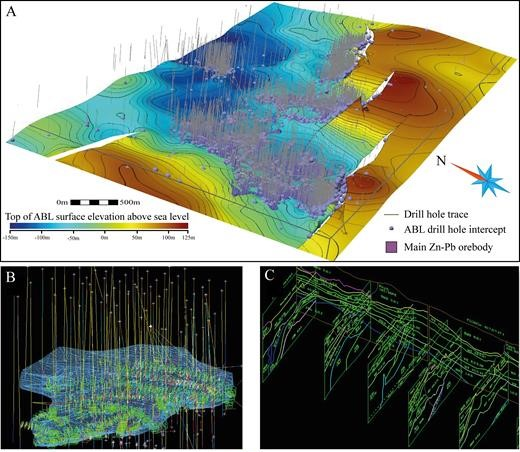Lisheen 3D model and datasets
This dataset contains a 3D geological model of Upper Devonian to Lower Carboniferous stratigraphies and faults in the Lisheen area, Co. Kilkenny, Ireland. The model was built to constrain the normal fault network controlling the Zn-Pb deposit and to constrain fluid flow pathways. The 3D model contains a detailed model of the base of Waulsortian Limestone formation horizon and the orebody resource. It also contains the major faults at the Lisheen deposit. The faults and horizon surface were explicitly picked and interpreted using surface and underground drilling, underground face mapping from the Lisheen mine dataset, underground structural information, and mineral resource estimation data, which are all included in the dataset.
Download the Lisheen data here.
Methodology
This methodology is also described in Kyne et al. (2019).
3D data were derived from digital archives. We used Maptek’s Vulcan modelling software to digitize horizon surfaces, fault lines, and volumes in areas of densely spaced data (i.e., within the individual orebodies), which has permitted the detailed delineation of the fault systems and stratigraphic horizons within the deposit. Once created, these interpreted surfaces, fault lines, and volumes were used as input data for Paradigm’s SKUA-GoCAD modeling software, coupled with Mira Geoscience’s Mining Suite plugins to extrapolate between areas of dense data to create complete fault arrays and horizon surfaces.
To best constrain the normal fault systems within both deposits, and to produce the most accurate fault displacements and geometries, data points contained within individual fault zones were reduced to a single fault surface (i.e., fault plane). Individual fault zones which are composed of fault rock and slip surface bounded, variably deformed host rock lenses, generally occur in tens of meter down to centimetre scales. At this scale, structures cannot be explicitly and fully mapped within 3-D models. In some cases, individual horizon points from drill hole intersections close to fault planes, which are known to be produced by localized inversion on normal faults, were ignored to produce surfaces that are akin to the initial normal fault geometries and pre-inversion displacements.

The figure above shows an example of the data used to model the base of the Waulsortian Limestone at Lisheen (Kyne et al., 2019).
Publications:
The full modelling methodology and dataset is described in the following two papers:
Kyne, R., Torremans, K., Doyle, R., Güven, J., Walsh, J.J. (2019). 3D modelling of the Lisheen and Silvermines deposits, Co. Tipperary, Ireland: Insights into structural controls on the formation of Irish Zn-Pb deposits. Economic Geology 114(1), 93-116. https://doi.org/10.5382/econgeo.2019.4621
Torremans, K., Kyne, R., Doyle, R., Güven, J., Walsh, J.J. (2018). Controls on metal distributions at the Lisheen and Silvermines deposits: Insights into fluid flow pathways in Irish-type Zn-Pb deposits. Economic Geology, 113(7), 1455-1477. doi.org/10.5382/econgeo.2018.4598
A related iCRAG paper also uses these models to look at fault-controlled fluid flow in extensional basins.
Walsh, J.J., Torremans, K., Güven, J., Kyne, R., Conneally, J., Bonson, C. (2018). Fault-controlled fluid flow within extensional basins and its implications for sedimentary rock-hosted mineral deposits. Society of Economic Geologists Special Publications 21, 237-269. http://doi.org/10.5382/sp.21.11
Terms of use:
These datasets are released under a CC-BY-NC v4.0 licence. Any published work should reference Kyne et al. (2019) and Torremans et al (2018). Where use is made of these data for any purpose, you must acknowledge the material. iCRAG would relish the opportunity to work with you on this data.
The following acknowledgement must accompany the reproduced iCRAG material:
This data uses models and data of the SFI Research Centre for Applied Geosciences (iCRAG) at University College Dublin, licenced under CC-BY-NC v4.0.”
Reproduction of any iCRAG materials does not amount to an endorsement by iCRAG, it’s institutions or any of its employees of any product or service and no such endorsement should be stated or implied.
iCRAG projects involved
The model was built by iCRAG in 2015-2017 as part of three projects: 3DPlatform, RM.TP1.1 and MODIO, as listed below.
- 3DPlatform: 3D modelling of the Irish Carboniferous Basins from regional down to mineral deposit scale.
- TP1.1.PD1: Structural evolution of Lower Carboniferous faulting and its links to fluid flow and mineralization.
- MODIO: Numerical Modelling of the Structural Controls on Irish Zn Pb Ore Deposits. Funded from the European Union’s Horizon 2020 research and innovation programme under the Marie Sklodowska-Curie grant agreement No. 745945.


